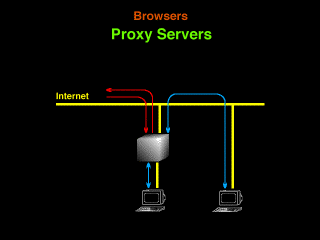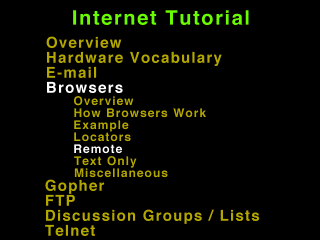 10-01
10-01


 10-00
10-00
Accessing browsers remotely. We will briefly discuss using browsers through firewalls and via dial-up phone lines.
Proxy servers can be used to firewall Web access or to serve as a cache to improve access time. Requests for web pages go to the proxy server which then re-issues the requests to the network. A caching proxy check to see if the web page you are requesting is in it's cache, and if so you get faster response times. Many universitys have cache servers to reduce traffic on the main campus internet feed.
Browsers can also be run via phone lines. Your PC would need to have Internet software that supported SLIP (serial line internet protocol), CSLIP (Compressed Header SLIP), or PPP (Point to Point Protocol). You would then dial into your service provider's terminal server or shell account and activate the serial protocol. Slirp is a freeware package for doing SLIP, CSLIP, or PPP from a normal Unix login account.
Contact your systems administrator before trying to use Slirp... they may already have it available or they may forbid it's use.
Text mode browsers let you move through hypertext in a text only format. It's faster, but not nearly as fun.
This is an example of a web page viewed with Lynx, a text mode browser. You move from link to link using the up and down cursor keys. A series of single character commands are available as detailed at the botton of the screen.
We have selected our list of bookmarks (saved hypertext links) by pressing the "V" key. We can then cursor up or down to highlight the site we wish to go to and then select it by pressing the "enter" key.
We have selected the University of Kansas site, the home of the Lynx browser.

